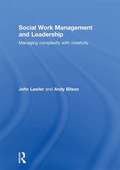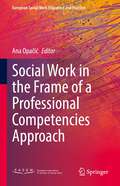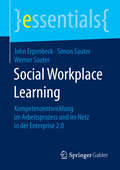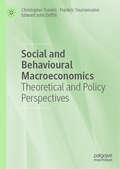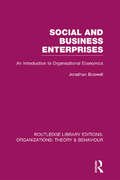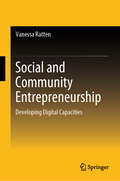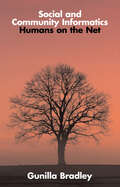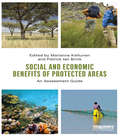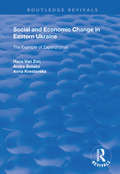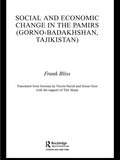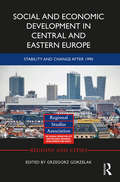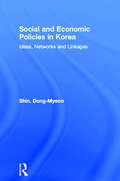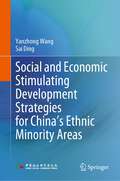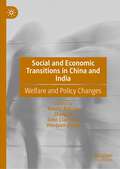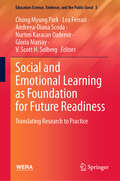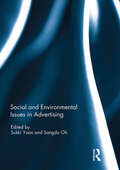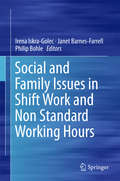- Table View
- List View
Social Work Management and Leadership: Managing Complexity with Creativity
by John Lawler Andy BilsonManagement and leadership are increasingly important within the organisation and delivery of social care services and now form part of the post qualification framework for social workers. Yet, whilst there is a relatively broad understanding of management concepts and their application in social care, their foundations often go unchallenged both by students and managers. Furthermore, leadership is open to a wide range of interpretations and is often ill-defined with the expectation that we share a common understanding of the term. This text promotes an appreciation of the development of management and leadership thinking and the different themes which inform current ideas. It considers these topics from a range of theoretical standpoints in order to stimulate readers to consider their own experience and expectations of management and leadership. It then demonstrates how these standpoints might promote innovative approaches to management and leadership within social care organisations and ways in which such organisations might then develop. The aim of this challenging text is to encourage critical and informed reflection on current practice. Social Work Management and Leadership is essential reading for students of management and leadership in social care as well as being an invaluable resource for managers who simply wish to consider new approaches to their practice.
Social Work and Integrated Health Care: From Policy to Practice and Back
by Victoria Stanhope Shulamith Lala Ashenberg StraussnerWith nearly 40% of social workers working in the health and behavioral health care sectors, Social Work and Integrated Health Care is designed to help social workers understand the policies that shape the current discussion regarding integrated primary care and behavioral health care and their application to practice. While the future of Patient Protection and Affordable Care Act of 2010 (PPACA) is uncertain at this time, the potential for integrated health care to simultaneously improve health outcomes while reducing costs means that despite the constantly changing health policy landscape, the movement towards an integrated health care system will continue in the future. As these changes occur, there is a great need in the social work field for resources that will give both the context for these changes and translate the policies to day-to-day social work practice. This book provides essential information about the important shifts in the health care field with a focus on health care for vulnerable populations, with a special emphasis on adults with severe mental illnesses and substance abuse disorders. As the title indicates, the book provides a comprehensive discussion not only of critical policy issues, but also their specific implications to evidence-based clinical practice. It covers such areas as background on public funding for health care, the development of behavioral health services in the community, and the passage of mental health parity legislation. The text also includes an overview of integrated health care settings and describes evidence practices that are central to integrated health care such as screening, person-centered care planning, motivational interviewing, and wellness self-management. It is a must-have text for all social work students in MSW programs.
Social Work in the Frame of a Professional Competencies Approach (European Social Work Education and Practice)
by Ana OpačićThis book serves as an introductory reader for understanding a professional competencies framework for social work through a new approach. It not only discusses what professional competencies are and why they are significant, but it also shows how to develop a professional competencies approach, measure and research competencies, and learn how to use them to empower professional identity and career development. There has been growing interest to define the social work profession within a professional competencies framework. Professional competencies are considered in their complexity as a triangle of knowledge, skills and values. They are not solely a tool for education and practice, but they are also important for professional socialization and identity in social work. A professional competencies approach has been used to define standards and expectations for social workers-practitioners; it is an evaluation tool for formal education and lifelong learning programs, provides guidance for field practice and placements for social work students, and could be a frame for distinguishing levels of professional expertise. The volume provides an up-to-date, comprehensive overview of a professional competencies approach in social work with 10 chapters organized in four sections:Part I: Understanding a Professional Competencies Approach, including Criticisms of the Competency-Based Education ApproachPart II: Major Areas of Professional Competencies, including Leadership and Professional Socialisation Part III: Measuring Professional Competencies and Education Outcomes, including How to Conceptualise, Operationalise and Measure Professional Competencies in Social WorkPart IV: Professional Competencies and Professional Development, including A Model of Holistic Competence in Social Work and the unique Professional Capabilities Framework Social Work in the Frame of a Professional Competencies Approach is essential reading for social work instructors, academics and national professional associations interested in developing or reviewing their professional competencies framework. It is an invaluable resource for experts in statutory bodies that set up a legislative framework of social work practice or work in the accreditation of social work education programs. The book is useful for social work students interested in understanding the theoretical background of social work, as well as for field practitioners who wish to use professional competencies for their self-reflection, self-evaluation and professional identity.
Social Workers: Finding Solutions for Tomorrow’s Society
by Camden FlathIn today's world, many movies are entirely animated using computers, video games have highly detailed graphics, and companies are becoming more dependent on well-designed websites. In each of these cases, artists work hard to create eye-catching, awe-inspiring, attention-grabbing visual content to entice viewers, players, or consumers. Changes in the entertainment we want, the ways businesses try to reach customers, and how we get our information in the twenty-first century are all creating new job opportunities for artists. The young adults of today will be the job force of tomorrow, so choosing a career that will best fit with the needs of the changing world will be important to job satisfaction and a successful life. With the vast array of career and job options, it will also be important for young adults to understand which work will be the best match for their interests, talents, goals, and personality types. Certain careers are expected to gain importance within the early decades of the twenty-first century. Careers in art, animation, and graphic design are among the job paths that will be growing steadily in the early part of the twenty-first century. The United States Bureau of Statistics predicts that employment in these industries is likely to grow slightly faster than the average rate for all occupations. If you are artistic, you may have been warned to find a job and just do art in your free time or you will never have any money. However, there may be a way to combine your art with a successful career--choose one of the jobs in this book and you won't have to starve!
Social Workplace Learning: Kompetenzentwicklung im Arbeitsprozess und im Netz in der Enterprise 2.0 (essentials)
by John Erpenbeck Werner Sauter Simon SauterDie Autoren analysieren, wie sich in der Welt der Enterprise 2. 0 und einer vernetzten Privat- und Arbeitswelt die Anforderungen an die Lernsysteme grundlegend verändern. Lernen und Arbeiten wachsen dabei zusammen. Das Essential erläutert praxiserprobte Lösungskonzeptionen für diesen Veränderungsprozess, um innovative Kompetenzentwicklungssysteme mit Blended Learning in Verbindung mit projektorientiertem Social Learning zu konzipieren, umzusetzen und zu implementieren. Auf diese Weise können Unternehmen eine Kultur kollaborativen Arbeitens und Lernens initiieren, die schrittweise zum Lernen im Prozess der Arbeit führt.
Social and Behavioural Macroeconomics: Theoretical and Policy Perspectives
by Christopher Tsoukis Frédéric Tournemaine Edward John DriffillDespite significant theoretical advances in social and behavioural macroeconomics, little has been done to synthesise the disparate developments in these fields and point the way forward to future research directions and policy implications. This book reviews, unifies and extends diverse strands of thinking and shows how these theories can be used to improve macroeconomic modelling for policy development in a range of spheres. The book explores how the most empirically relevant socio-behavioural traits can widen the scope of macroeconomics to fruitfully address new issues and challenges, such as rising inequality, the change in the functional distribution of income (labour and capital shares), and a further understanding of the government spending multiplier. Chapters also address more traditional topics such as macroeconomic policy effectiveness, growth, saving and labour supply. Other, more open-ended themes of the book include whether the concept of individual rationality should be complemented by collective rationality; whether socio-behavioural traits underlie socially inefficient outcomes such as tragedies-of-the-commons, rat races, financial crises and global warming; and whether such traits can provide new foundations for (New) Keynesian macroeconomics. This book will be essential reading for advanced researchers and students working in macroeconomics and other social sciences, including psychology and politics, as well as those working on the theoretical end of public policy.
Social and Business Enterprises: An Introduction to Organisational Economics (Routledge Library Editions: Organizations)
by Jonathan BoswellThis book shows how economics can be used to clarify and stimulate thinking about organisations and their decision problems. It is mainly designed for university students of economics, management and business studies and of public and social administration. But its clear and lively exposition will have a wider appeal. The author introduces economic controversies on organisational power, exchange and self-interest, generosity and public spirit. He outlines many practical uses of such concepts as marginalism, opportunity cost, time preference and risk, scale economies and diseconomies, market power, public goods and externalities. He applies economics to business planning and budgeting problems and also to the problems of social enterprises in obtaining resources through charges and grants and in allocating these resources ‘efficiently’ and ‘fairly’. A distinctive feature of the book is that it analyses problems in the wide context of business, public and voluntary organisations. Unlike many conventional texts it is not highly abstract, technical or descriptive. Drawing on his extensive experience, the author provides many real-life and typical case studies to highlight his central theme: the fruitful interaction between abiding economic ideas and contemporary organisational problems.
Social and Community Entrepreneurship: Developing Digital Capacities
by Vanessa RattenThis book focuses on both social and community developments within an entrepreneurship perspective, thereby highlighting the need to foster public and non-profit initiatives that combine with financial needs. Social and community entrepreneurship is a distinct form of entrepreneurship that combines profit and non-profit initiatives. This book helps to encourage social and community enterprises to integrate digital capabilities. Specific business examples of social digital enterprises will be discussed in the textbook together with community-led initiatives.
Social and Community Informatics: Humans on the Net
by Gunilla BradleyAs a discipline, Informatics has developed over the years from its initial focus on data processing and software development, towards a more recent emphasis on people’s use of technology and its impact on their working and private lives. Gunilla Bradley, an internationally recognized expert in this field, has researched this area for many years and here, authors this indispensable volume on the topic. Providing a broad and deep analysis of the relationship between people, ICT, society and the environment, Bradley examines the impact on/change in organizations and individuals, both in the workplace and in the home. Taking a firmly humanistic view she also looks to the future as ICT increasingly transforms and impacts on our lives, and explores issues including stress, power, competence and psychosocial communication. She proposes normative research questions for the future and presents actions to achieve the Good ICT society. This thought-provoking book will be of interest to students and academics studying social informatics, computing and MIS as well as organizational behaviour, sociology, psychology and communications. Research-based and cross-disciplinary, Bradley's book is a valuable, and topical, resource.
Social and Cultural Foundations of Counseling and Human Services: Multiple Influences on Self-Concept Development
by John J. SchmidtSocial and Cultural Foundations of Counseling addresses the fundamental social and cultural foundations upon which counselors and other helpers develop the knowledge and skill to work effectively with diverse populations. The premise of this text is that such foundational knowledge includes learning about self-concept development within a cultural and sociological context and about the impact that both individual differences and collectivistic philosophies have on cultural and personal identity.
Social and Economic Benefits of Protected Areas: An Assessment Guide
by Marianne Kettunen Patrick Ten BrinkProtected areas (PAs) contain biodiversity and ecosystems of high conservation value. In addition, these areas provide a range of benefits, both direct and indirect, to our societies and economies, i.e. so called ecosystem services. These services include, for example, an ecosystem's ability to regulate floods and climate, purify water, secure the pollination of crops, and create opportunities for recreation, culture and tourism. This book offers a comprehensive introduction to the socio-economic benefits of PAs and PA networks and provides step-by-step practical guidance on identifying, assessing and valuing the various ecosystem services and related benefits provided by PAs. It also aims to improve the communication of PA benefits to different stakeholders and the general public. It is shown that identifying and valuing the socio-economic benefits of PAs can be beneficial for several reasons. Demonstrating socio-economic importance of a protected site can significantly increase political and stakeholder support for the site and resolve conflicts between different interest groups. This can lead to positive changes in policies and decision-making. Insights on PA benefits are also needed to identify a combination of actions and land use practices that best support the sustainable and equitable utilisation of these benefits, while retaining a site’s conservation goals. Finally, demonstrating different benefits can help to discover alternative and sustainable sources for financing the management of PAs.
Social and Economic Change in Eastern Ukraine: The Example of Zaporizhzhia (Routledge Revivals)
by Hans van Zon Andre Batako Anna KreslavaskaFirst published in 1998, this deeply engaging volume describes the ‘great transformation’ of our time. While transformation, it is definitely not a transition to the market economy, civil society and democratic rule. Instead, this book maps the growth of the economic jungle, clan society and a corrupted, criminalised state. Capitalists but no capitalism. Watching Warsaw, Prague and Budapest, one should not forget about Zaporizhzhya. After this book, one cannot.
Social and Economic Change in the Pamirs (Gorno-Badakhshan, Tajikistan): Translated from German by Nicola Pacult and Sonia Guss with support of Tim Sharp
by Frank BlissSince Olufsen and Schulz published their monographs on the Pamirs in 1904 and 1914, respectively, this is the first book to deal with the history, anthropology and recent social and economic development of the Pamiri people in Gorno-Badakhshan, Eastern Tajikistan. After the collapse of the Soviet Union, such high mountain areas were more or less forgotten and people would have suffered severely from their isolation if an Aga Khan Foundation project in 1993 to 1994 had not afforded broader support. The reader will be confronted by an almost surrealistic world: Pamiri income and living conditions after 1991 dropped to the level of a poor Sahelian country. Former scientists, university professors and engineers found themselves using ox-ploughs to plant potatoes and wheat for survival. On the other hand, 100% literacy and excellent skills proved to be an enormous human capital resource for economic recovery. The first sign of this was an increase in agricultural production, something that had never occurred during Soviet times.
Social and Economic Development in Central and Eastern Europe: Stability and Change after 1990 (Regions and Cities)
by Grzegorz GorzelakThe integration of post-socialist Central and Eastern Europe into the EU is one of the success stories of European development. The region has seen significant economic convergence, dramatic changes in socio-economic indicators and improvements in the natural environment. However, some challenges remain, such as political divergence, public governance issues and population demographics. This book identifies and analyses the key post-1990 developments across the New Member States at the sub-national and national levels, with frequent country-level and regional comparisons. Careful attention is paid to drawing out commonalities in development trajectories while appreciating each country’s unique context. Drawing on the academic literature and illuminating empirical material, the broad range of topics discussed in the book paints a detailed picture of both change and stability in Central and Eastern Europe. It will be valuable reading for advanced students, researchers and policymakers in regional studies, European studies, human geography, political economy and transition economics.
Social and Economic Impact of Earth Sciences
by Vineet K. Gahalaut M. RajeevanThis book collects research papers on the economic and social impact of earth sciences. It covers topics related to weather forecasting, climate modelling, monsoon variability, air pollution, heat and cold wave, deep sea mineral and living resources, ocean state monitoring, tsunami and earthquake monitoring, desalination, coastal research, etc. The book focuses on the activities of the Ministry of Earth Sciences, India, in promoting the societal and economic impacts of earth science research in a simple language and in the form of stories and case studies, so that people with basic science degree can understand them.
Social and Economic Networks
by Matthew O. JacksonNetworks of relationships help determine the careers that people choose, the jobs they obtain, the products they buy, and how they vote. The many aspects of our lives that are governed by social networks make it critical to understand how they impact behavior, which network structures are likely to emerge in a society, and why we organize ourselves as we do. In Social and Economic Networks, Matthew Jackson offers a comprehensive introduction to social and economic networks, drawing on the latest findings in economics, sociology, computer science, physics, and mathematics. He provides empirical background on networks and the regularities that they exhibit, and discusses random graph-based models and strategic models of network formation. He helps readers to understand behavior in networked societies, with a detailed analysis of learning and diffusion in networks, decision making by individuals who are influenced by their social neighbors, game theory and markets on networks, and a host of related subjects. Jackson also describes the varied statistical and modeling techniques used to analyze social networks. Each chapter includes exercises to aid students in their analysis of how networks function. This book is an indispensable resource for students and researchers in economics, mathematics, physics, sociology, and business.
Social and Economic Policies in Korea: Ideas, Networks and Linkages (Routledge Advances in Korean Studies)
by Dong-Myeon ShinThe sustained remarkable economic growth in the East Asian countries - Japan, South Korea, Taiwan, Hong Kong and Singapore - has brought about a great deal of debate over the role of the state in the market and society. Shin analyses the dynamic process of state interventions in the economy and social affairs in Korea from the early 1960s until the present with special reference to five policy areas: macro-economic policy, industrial policy, social security policy, labour policy, and education and training policy.Social and Economic Policies in Korea develops a unique explanation about the development of Korean social policy using the concepts of 'policy idea', 'policy network', and 'policy-linkages' to examine the causes, patterns and consequences of state interventions in the economy and social affairs over time. It should interest students and researchers of East Asian studies, social policy and development studies.
Social and Economic Stimulating Development Strategies for China’s Ethnic Minority Areas
by Yanzhong Wang Sai DingThis book gathers the outcomes of various, extensive research efforts on building a moderately prosperous society in minority areas, which would allow China’s poor and poverty-stricken areas to comprehensively join the rest of society. Offering an essential reference guide, the book will help readers understand the process, achievements, problems, and future development with regard to building a moderately prosperous society in the new era.
Social and Economic Transitions in China and India: Welfare and Policy Changes
by John Clammer Keerty Nakray Zhang Yi Wenjuan ZhangThis book conducts a comparative analysis of social and economic changes in the welfare state transformations in China and India, at national and sub-national levels. Discussions are made based on impacts from the social and economic changes in the last century and the fourth industrial revolution on welfare state transformations in China and India, the world's two largest countries in terms of population and density.First-hand empirical work is conducted by a group of scholars from India and China, which draws on inter-disciplinary and cross-cultural academic traditions to deepen social, cultural and legal understanding between the two countries.This book would appeal to undergraduate and graduate students in comparative sociology, political science, law and comparative welfare studies as well as researchers in these fields, as well as researchers in policy think-tanks and research institutes and officials in government and non-governmental organizations.
Social and Emotional Learning as Foundation for Future Readiness: Translating Research to Practice (Education Science, Evidence, and the Public Good #3)
by V. Scott H. Solberg Chong Myung Park Lea Ferrari Andreea-Diana Scoda Nurten Karacan Ozdemir Gloria MarsayThe book offers a global perspective on social and emotional learning skills (SEL) by summarizing findings from a collaborative multi-national and cross-cultural study of educator perceptions regarding the nature and value of SEL skills conducted by career development researchers from 19 countries. In addition to promoting success in education, SEL skills serve as the “durable,” human skills that support success in the world of work. The chapters explore research from three key regions: the Global South, Asia, and the Global North. Alongside comparative analyses of SEL, the book highlights strategies for designing culturally responsive interventions to develop SEL and future-readiness skills. Each region provides tailored recommendations for implementing SEL and career development programs and services. This collaborative research effort offers a unique opportunity to reexamine assumptions underpinning career development theory and practice. It presents a transformative research model that conceptualizes SEL skills policies and practices that are responsive to the diverse sociopolitical contexts and cultural values found in different regions around the world.
Social and Environmental Disclosure by Chinese Firms
by Indra Abeysekera Yingjun LuGiven the increased social and environmental problems in China, this book looks into the social and environmental (environmental) disclosure practices of socially responsible Chinese listed firms by constructing a stakeholder-driven, three-dimensional, disclosure index. The book contains a three-part study: the first part explores the current status of social and environment disclosure practices. The second part empirically examines the relationship between corporate social and environmental disclosure and various influencing factors (i.e. stakeholders’ power and corporate characteristics). The third part empirically examines the link between corporate social responsibility (CSR) reporting (i.e. publishing a CSR report and the quality of the CSR report) and socially responsible reputation. The book finds that the CSR report provided more stakeholder-relevant social and environmental disclosure than the annual report. It also finds that corporate characteristics such as firm size, profitability and industry classification are all statistically significant factors influencing social and environmental disclosure of the Chinese firms studied. Shareholders significantly influenced firms’ social and environmental disclosure, and creditors significantly influenced firms’ disclosure related to their environmental performance. The final part of the study reports that publishing a CSR report and CSR reporting quality had a positive influence on firms’ socially responsible reputation and that the CEO/chairman duality negatively influenced firms’ socially responsible reputation. The book also highlights that financial performance and firm size were the two corporate characteristics that had a positive influence on corporate socially responsible reputation. This book will be of interest to those who are keen to learn more about corporate social responsibilities in the context of Chinese firms.
Social and Environmental Disclosure by Chinese Firms
by Indra Abeysekera Yingjun LuGiven the increased social and environmental problems in China, this book looks into the social and environmental disclosure practices of socially responsible Chinese listed firms by constructing a stakeholder-driven, three-dimensional, disclosure index. The book contains a three-part study: the first part explores the current status of social and environment disclosure practices. The second part empirically examines the relationship between corporate social and environmental disclosure and various influencing factors (i.e. stakeholders’ power and corporate characteristics). The third part empirically examines the link between corporate social responsibility (CSR) reporting (i.e. publishing a CSR report and the quality of the CSR report) and socially responsible reputation.The book finds that the CSR report provided more stakeholder-relevant social and environmental disclosure than the annual report. It also finds that corporate characteristics such as firm size, profitability and industry classification are all statistically significant factors influencing the social and environmental disclosure of the Chinese firms studied. Shareholders significantly influenced firms’ social and environmental disclosure, and creditors significantly influenced firms’ disclosure related to their environmental performance. The final part of the study reports that publishing a CSR report and CSR reporting quality had a positive influence on firms’ socially responsible reputations and that the CEO/chairman duality negatively influenced firms’ socially responsible reputation.This book will be of interest to those who are keen to learn more about corporate social responsibilities in the context of Chinese firms.
Social and Environmental Issues in Advertising
by Sukki Yoon Sangdo OhIn the past few decades, attention has turned to the need to apply commercial marketing concepts, knowledge, and techniques to promote goods, services, and actions that enhance consumer well-being and social welfare through socially and environmentally responsible advertising, for example, recycling promotions. Critics argue, however, that for-profit advertisers who endorse social responsibility are inherently serving commercial purposes and diluting the value of socially responsible advertising. Scholars in many fields—advertising, marketing, communications, and psychology—explore ways to encourage consumers, companies, and policymakers to adopt socially responsible behaviours, and to provide theoretical and practical insights regarding effective applications of pro-social and pro-environmental marketing messages. This book comprises ten chapters that contribute to advertising theory, research, and practice by providing an overview of current and diverse research that compares, contrasts, and reconciles conflicting views regarding social and environmental advertising; uncovering individual differences in perception of advertising messages and their consequences for social and environmental behaviours; reconciling societal and business interests; identifying a message factor that determines eco-friendly behaviours; and identifying source factors that enhance and weaken advertising effectiveness. This book was originally published as a special issue of the International Journal of Advertising.
Social and Family Issues in Shift Work and Non Standard Working Hours
by Irena Iskra-Golec Janet Barnes-Farrell Philip BohleThis book explores the effects of shift work and non standard working hours on family and social life. It features analysis and case studies from an international body of researchers from Europe, the Americas and Australia. It includes contributions from Germany, the United States, the Netherlands, Croatia, Italy, Poland, Australia, and Brazil, that fully examine this increasingly prevalent, and global, issue. The book starts by introducing the problems of work-family linkages, shift work and non-standard work hours. Next, it details the consequences of specific features of shift schedules, such as decreased opportunities for social participation, family problems and negative effects on partners and children as well as the impact of working time arrangements on work-family conflict over time. The book then looks at the consequences of shift work and non-standard work hours on family members and the workers themselves, including the sleep and daytime functioning of adolescent family members and the ways that non-standard work schedules intersect with the particular challenges and stresses of family responsibilities and strategies that workers use to manage these challenges in sectors where non-standard schedules are the norm. Last, the book considers the role of individual differences in understanding problems of work-family relationships, including a consideration of safety and health at work from the perspective of gender and an examination of the moderating role of chronotype and circadian type characteristics on work-family conflict and work-family facilitation among male shift workers.
Social and Human Factors: Reactions to Change
by Harvard Business Review PressWhen implementing change companywide, it is important to remember the influence of social systems within the organization. This chapter notes that successful change management requires that managers recognize this influence and take it into consideration as they make necessary changes to their style of management.
